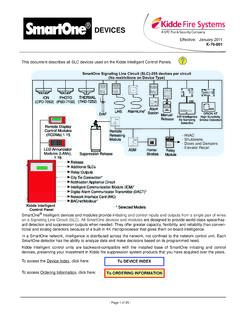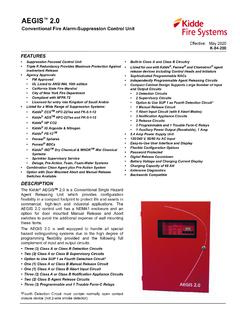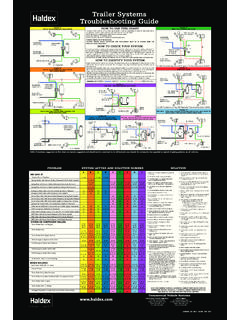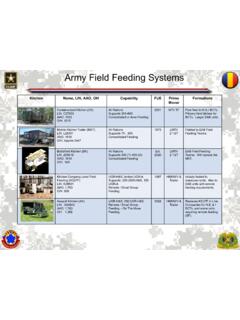Transcription of IGNITION 101: GAS IGNITION SYSTEMS - Kidde-Fenwal, Inc.
1 Direct Spark or Hot Surface?Gordon Swanson, Business Director-Fenwal ControlsAutomatic IGNITION SYSTEMS are a key component of gas-fired products. The safe and reliable function of such equipment depends on consistent, controlled operation of the IGNITION source. Determining the type of IGNITION to use and how to correctly implement it within a given product is crucial to successful performance. In addition, there are other important factors to consider. It is very helpful to have an understanding of the two basic types of gas IGNITION , Direct Spark (DSI) and Hot Surface (HSI), their strengths and weaknesses and the proper application of each. It is also advantageous to consider new technology that may defy conventional wisdom about Hot Surface IGNITION . Direct Spark: On the Plus SideFIGURE 1:High voltage creates an arc between the two rods of an electrode located in the gas stream above the who has ever started a car has put Direct Spark IGNITION to work.
2 The car's IGNITION coil generates a high voltage charge that arcs across the spark plug, directly igniting the fuel/air mixture in the engine. Such a spark is also used in most appliances to directly light the flammable gas at the burner assembly. In larger equipment such as boilers or commercial gas stoves, a two-step process is used. The spark first lights a pilot or a small burner, which when proven to be lit, lights the main burner. This two-step system is called "spark-to-pilot" or "intermittent pilot" (IP) IGNITION , and is widely used to eliminate the gas required to continuously operate a standing pilot. Reliable "Flame Sensing" is an important feature of modern gas IGNITION SYSTEMS . Knowing when the flame is lit (and importantly, when it is not lit) is the key to safe operation. This isaccomplished by passing a small amount of current through the flame to ground. The controldetects changes in current caused by the presence or absence of a flame.
3 The same electrode that lights the flame can also act as the flame sensor in a system known as "Local Sense.""Remote Sense" uses a separate sensing rod positioned at an optimal location in the combustion chamber relative to the 101: Gas IGNITION SystemPage 1 IGNITION 101: GAS IGNITION SYSTEMS The most frequently cited advantage of DSI is cost. Electrodes and flame sensors are very economical, typically much lower cost than hot surface igniters. They are also very rugged, not prone to breakage and are manufacturers that build the IGNITION controls, electrodes, flame sensors and associated cabling can provide a great deal of application assistance in the design, materials and proper location of the electrode and the flame sensor in the combustion , DSI controls are microprocessor based with configurable software to control the complete and often-complex IGNITION sequence including the operation of the gas valve(s) and blower(s) in response to heating demands.
4 Typical sequences include initial diagnostic check at start up, pre-, inter- and post-purge timings, single and multiple trials for IGNITION , trial for IGNITION time (TFI), soft or hard lockouts and other functions such as a dual-rate or a modulating system . Self-diagnostics are often included with error codes displayed via an on-board LED or remote 2:Electrodes and flame sensors are constructed in an almost infinite variety of configurations to suit the burner and combustion chamber Flame Sense(Sense only)FIGURE 3: Right and wrong positioning of electrodes relative to the burner and FlameSense (Spark and Sense) IGNITION 101: Gas IGNITION SystemPage 4: Typical DSI controls for 12 VDC, 24 VAC and 120 VAC. Note the large cylindrical spark transformer that generates the high voltage IGNITION collaboration with the control supplier early in the design process allows optimization of the IGNITION sequence for a given piece of equipment.
5 Since all functions are managed by software, various options can be tested and proven in laboratory and field trials before the product goes to production. In all cases, the DSI control is designed to be a fail-safe device that is approved by agencies such as UL, CSA and spark applications and limitationsThe economy, ruggedness, long life and low maintenance of DSI make it ideal for many appliances, furnaces and boilers. DSI SYSTEMS light the gas very quickly, and are therefore useful in commercial cooking applications where response time to a call for heat must be Spark designs (Fig. 4, far right) are practical for appliances where one IGNITION control is used to simultaneously light and sense two burners at separate locations in appliances such as continuous broilers and fryers. DSI is also used in portable and even mobile "over the road" applications such as furnaces and water heaters for recreational vehicles, construction heaters, and asphalt pavers.
6 Direct spark IGNITION is also widely used in rooftop HVAC units that are subject to rigging and handling shocks during shipping and functions by creating a rapid series of high-voltage electric sparks, which means DSI controls generate electromagnetic interference (EMI) during their trial for IGNITION . This electricalnoise can interfere with nearby electronic components and even with the IGNITION control spark SYSTEMS must be installed with cables routed to minimize EMI issues. The ignitioncables should also be kept as short as practical to minimize spark energy losses. Although more costly, suppression spark cables are preferred over high-voltage wires as they significantlylessen noise emission. Gas IGNITION controls are not position sensitive, so they can be installed in any orientation for the most direct wiring and shortest runs. Avoid crossing wires and runningthe high voltage cable across the 101: Gas IGNITION SystemPage and secure grounding of any type of control system (DSI or HSI) is the key to reliable, consistent operation.
7 Our experience is that correcting a defective ground resolves many trouble the exception of the migration from analog designs to microprocessors (which provide a much more accurate and configurable product), the development of DSI controls has been evolutionary rather than revolutionary. Continually improving noise immunity and product reliability through testing, component selection and customized software is an ongoing effort. A combination of proper installation, proven hardware and intelligent software design allows the DSI control to immediately recover from any noise issues as well as minimize external surface IGNITION - a high temperature element replaces the sparking electrodeFor applications where there are high gas flows or when minimizing electrical interference is a primary goal, hot surface IGNITION SYSTEMS are often a preferred controls perform a similar IGNITION sequence to that of DSI controls, but rather than a spark, the devicethat ignites the gas is a "heated element" often called a "glow bar" similar to that used in a diesel engine.
8 This "hot surface" igniter is constructed of a semi-conductive ceramic materialthat heats up rapidly when voltage is applied. Instead of the high voltage spark transformer on the DSI control, there is a relay on the HSI control that directs power to the hot surface element for a defined period of time as part of the control sequence before the gas valve is opened. This allows the element to exceed the IGNITION temperature of the gas prior to the gas valve opening for the first TFI. In some sequences, the power to the hot surface element remains on during part or all of the 5: Examples of DSI applications include RV, commercial Dryers,Water Heaters, Infrared Heaters and Construction Equipment IGNITION 101: Gas IGNITION SystemPage are two varieties of Hot Surface Controls: "Basic," in which the program waits a designated amount of time before opening the gas valve, and "proven" in which the control monitors the increasing resistance in the hot surface element and thus "proving" the temperature of the igniter.
9 Proven hot surface IGNITION is useful for large SYSTEMS , typically 400K to Million BTU's in size where delayed IGNITION or a "hard start" could damage to the combustion chamber due to the rate of gas flow. Therefore, before the gasvalve is opened the IGNITION control looks for a "proving" current level before it will allow the gas valve to hot surface IGNITION involves applying line voltage to the igniter element (rather than high voltage to an arc device) there are no electrical noise issues as associated with direct spark and a little likelihood of interference with neighboring components. Hot surface is also preferred by some designers to be a more "positive" IGNITION method as there is a large, "glowing" high temperature element that ignites the gas rather than a small spark across an electrode 6: Typical hot surface controls can be distinguished from DSI controls as they do not utilize a spark 7:Hot surface igniters come in a variety of designs, including some with guards to protect against accidental damage from 101: Gas IGNITION SystemPage applications and limitationsHot surface IGNITION is the obvious choice for applications in which EMI is a major consideration, such as residential hot air SYSTEMS .
10 Hydronic units, such as pool and spa heaters, also utilize hot surface IGNITION to assure reliable lighting of their higher BTU compared to DSI, cost and time to achieve IGNITION are the disadvantages to hot surface. A hot surface igniter can cost two to three times as much as a direct spark electrode. Also, hot surface igniters require a heat-up period to reach the IGNITION temperature of the gas prior to the opening of the gas valve. The delay after a call for heat ranges from 4 to 40 seconds before the burner lights, and may prevent the use of HSI on SYSTEMS such as commercial cooking equipment which require short, frequent heatcycles for tight temperature control. The service cost of HSI can also be a major factor when the relative fragility of the ceramic igniter is considered. HSI elements are generally considered much more sensitive to breakage due to shock, vibration and impact than first recommendation to customers who experience breakage problems with hot surface igniters is to carefully review the location and positioning of the ceramic just moving it within the appliance or changing the orientation will solve the breakage important consideration is that HSI elements are poor flame sensors when compared to electrodes.
















